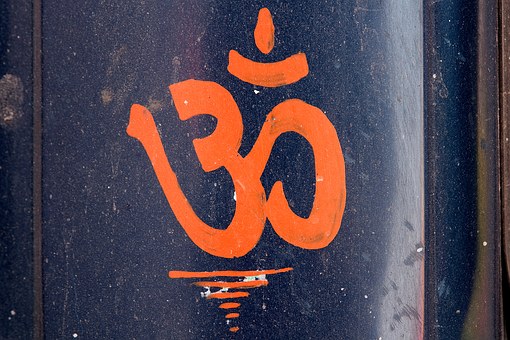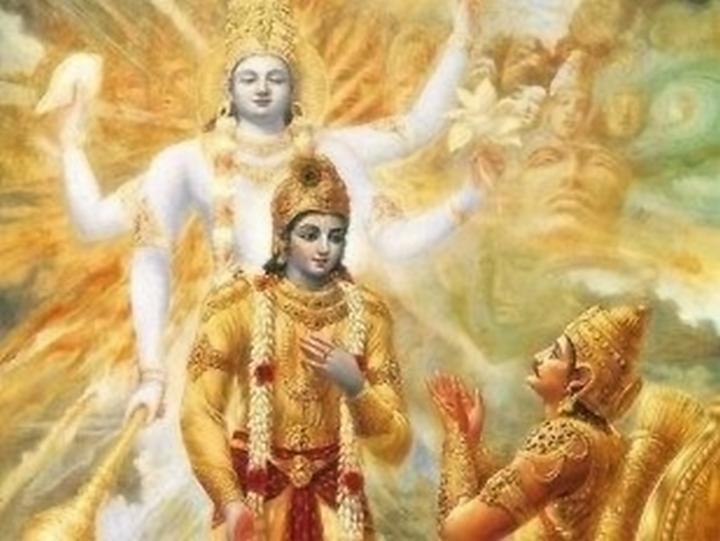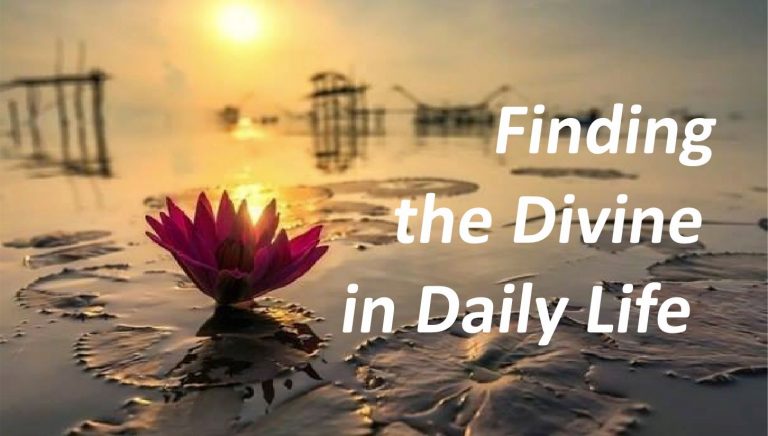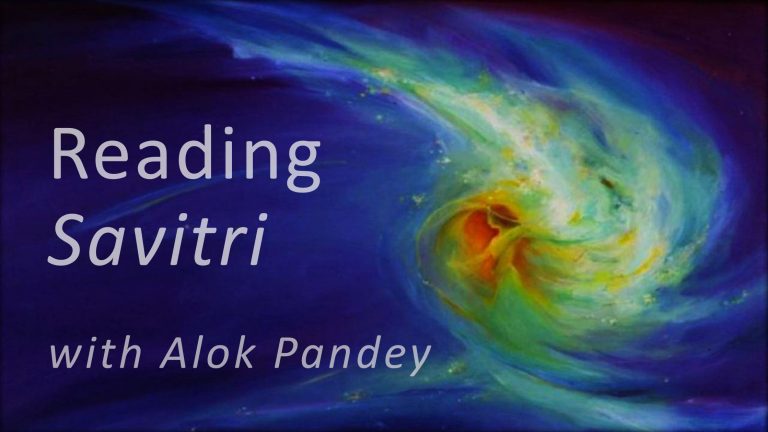India is a land that abounds in scriptures, the most authoritative of which are the Vedas. It is said that the Vedas have emerged from the mouth of the great creator Brahma himself. In other words the Vedas represent that Truth that has been laid down as the base and support of creation. It is the book of the Creator that describes and explains to us the why and how of creation, the wisdom and the power that has gone forth in it. Based upon this deeper Knowledge, the Vedas also give us the Science and Art of life as well as its secret inner commerce. Of course it is a deeper science than the material science that studies objects from the outside and then probes deeper based on the data received by our sense-mind. Our material science is a science of appearances. It tells us something about the external composition and the material forces that constitute an object, its physical properties, so to
say. But the Vedas reveal to us the deeper fabric of creation and created things, the subtler and occult dimension of shapes and forms and properties, their symbolic sense and their rightful place in the total scheme of things. This Knowledge is secret and hidden from our mind and senses but it can be received by transcending the mind, through inspiration, revelation, intuition and illumination, the four goddesses (Ila, Mahi, Saraswati, Sarama) and their powers. Thus did the Rishis receive it and revealed it to man. Therein lies the great value of the Vedas. The Vedas are the essence of all knowledge.
Then there are the Upanishadas that make the Vedas accessible to man’s awakened  intelligence. The truths of the Vedas are given a form less mystic, more comprehensible. The deeper symbol and occult formulas of the Vedas is brought into the realm of thought and higher intelligence. While many of the Vedic truths cannot be easily grasped by the logical mind or even by that higher faculty of discrimination called as Buddhi, the Upanishadas touch the Buddhi and awaken it to Light and we can begin to grasp by reflection something of that Glory that is otherwise too bright for our death-bound eyes. The divine logic of creation becomes clearer to our sight and from this vision flows naturally the right way to live and be. This is the great contribution of the Upanishadas.
intelligence. The truths of the Vedas are given a form less mystic, more comprehensible. The deeper symbol and occult formulas of the Vedas is brought into the realm of thought and higher intelligence. While many of the Vedic truths cannot be easily grasped by the logical mind or even by that higher faculty of discrimination called as Buddhi, the Upanishadas touch the Buddhi and awaken it to Light and we can begin to grasp by reflection something of that Glory that is otherwise too bright for our death-bound eyes. The divine logic of creation becomes clearer to our sight and from this vision flows naturally the right way to live and be. This is the great contribution of the Upanishadas.
Where then does the Gita stand amidst all this stupendous mass of revelatory scriptures whose sheer size and of course the substance is mind-boggling? One may even ask what extra truth if any does this rather short treatise of just about 700 shlokas bring? Is it just a compendium of the Vedas and the Upanishadas as some say, – ‘the Gita is the essence of the Upanishadas’, – or is there something more in it? Well, in a sense it is true that whatever has followed subsequently has in one way or the other carried the stamp of the Vedas. And yet there is something that we find in the Gita that we find nowhere before it. This something consists in the Idea of the Avatara and as a natural corollary man’s relation with the Incarnate God. Of course we find this idea developed later in the Puranas, especially the Srimada Bhagwata Purana. But in the Gita it is thrown as a seed with such a great force and power that just those four shlokas that relate directly to the Avatara can potentially transform the way we look at our self and the world. These four slokas are:
‘Though I am the Unborn, though I am Imperishable in my Self-existence, though I am the Lord of all-existences, yet I stand upon my own Nature and I come into birth by my Self-maya.
Whensoever there is the fading of the Dharma and the uprising of unrighteousness, then I loose myself forth into birth.
For the deliverance of the good, for the destruction of the evil-doers, for the enthroning of the Right, I am born from Age to Age.
He who knoweth thus in its right principles my divine birth and my divine work, when he abandons his body, comes not to rebirth, he comes to Me, O Arjuna.’
[The Gita: Fourth Chapter: Slokas 6 to 9]

The passages strike us with a force even in their simplicity. The first is of course about the principle and process of Avatarahood. The Divine who transcends all existence, the Lord of Nature and of all that exists, yet chooses to enter the magic fence of nature that appears to us as an impregnable fortress, hard to overcome, Maya duratya. Thus born, He seems to limit Himself, be born and die as ordinary human beings and yet, He remains ever and always, the same Unborn and Imperishable Lord all existence. He is higher and greater than Brahma himself as is well illustrated in one of the stories of the Srimada Bhagwatam. He is beyond creation, the one Supreme existence from whom all existences derive. The Vedas sing His Glory, the Upanishadas reflect the Light of His eyes, the Puranas only try to capture something of His Greatness and Power. The trinity are only three moods and the Gods aspects and powers of His infinite Being. And yet, that Unborn, who transcends and exceeds all existence takes birth in a human form. This secret is found nowhere, not even in the Vedas and the Upanishadas that speak of the ascent of creation with man as the link towards the Supreme. But not of the Divine Descent into creation to uplift and redeem it.
The next two slokas reveal the nature and the purpose of this Descent. It is a descent in response to the cry of earth and men as the later Puranas developing upon this Idea will put it. It is not only the earth that longs and aspires for the Supreme, the Supreme too has a special linking for earth and descends here from time to time. Earth is His favourite in a sense and He would not abandon it to dark powers. True, these powers of darkness may have their term and play for a while. They may even seem to be on the ascendance for the moment, but not beyond a point. The Divine sees to it that when the balance of earth is disturbed and goodness and righteousness shrinks from the heart of mankind, then He descends again to take charge of the evolutionary journey, to turn the tide of thought and lead the march of mankind upwards again. He descends to rekindle faith, to reawaken the great effort, to establish the True, the Good, and the Beautiful once again.
Finally, we have this great secret revealed, that he who knows this truth about the Divine Birth and the Divine Works is released from all bonds of birth and death and comes straight unto the Supreme Lord. The Lord has already alluded to this as the highest secret, rahasyhyam hyotaduttamam, before revealing it to Arjuna. To the unchaste mind this may seem like an exaggeration of sorts. How can merely knowing that the Divine is born amidst the tumult of creation to redeem it save us from the cycle of birth and death? As if to emphasise and elaborate this truth, the Incarnate Divine repeats this secret once again, a little later. The Lord reveals:
What I am going to tell thee, the uncarping, is the most secret thing of all, the essential knowledge attended with all the comprehensive knowledge, by knowing which thou shall be released from evil. [The Gita: Ninth Chapter: Sloka 1]
Here again, the Lord emphasizes that one needs faith to receive this knowledge, this king-secret, rajguhyam:
The soul that ails to get faith in the higher truth and law, O Parantapa, not attaining to Me, must return into the path of ordinary mortal living.
[The Gita: Ninth Chapter: Sloka 3]
The Lord reveals how this secret is higher even then the knowledge one receives from the three Vedas. Having revealed through a series of slokas, the supreme nature of the Godhead who is ever present in all beings and things, though most of all in the human body, manavi tanu asritam, the Lord goes on to lay emphasis once again on this aspect of redemption with faith and devotion:
‘If even a man of very evil conduct turns to Me with a sole and entire love, he must be regarded as a saint […] Swiftly he becomes a soul of righteousness and obtains eternal Peace. This is My word of promise, O Arjuna, that he who loves Me shall not perish, na me bhakta pranasyati.’ [Slokas 30 – 31]
Finally, towards the close of this luminous discourse, He once again reveals this highest of all secrets, guhyad guhyataram, sarva guhyatamam, whereby faith, devotion, and surrender is emphasized in ‘two brief and direct slokas’:
‘Become My-minded, My lover and adorer, a sacrificer to Me, bow thyself to Me, to Me thou shall come, this is my pledge and promise to thee, for dear art thou to Me. [Sloka 65]
Abandon all dharmas and take refuge in Me alone. I will deliver thee from all sin and evil, do not grieve.’ [Sloka 66]
Of course this knowledge is not a mere mental knowledge or the logical acceptance of a possibility. It is a seeing by the eye of faith. This faith that is much more than mere belief and acceptance of a doctrine, is a power that helps us to love and surrender to the Incarnate Divine. And it is this act of surrender that brings the desired result. Faith, devotion and surrender become the great secret of redemption.
The Mother and Sri Aurobindo reveal to us the mystery behind this greatest of all secrets:
‘If you rise high enough, you find yourself at the heart of all things. And what is manifest in this heart can manifest in all things. That is the great secret, the secret of the divine incarnation in an individual form, because in the normal course of things what manifests at the centre is realised in the external form only with the awakening and the response of the will in the individual form. Whereas if the central Will is represented constantly and permanently in an individual being, this individual being can serve as an intermediary between this Will and all beings, and will for them. Everything this individual being perceives and offers in his consciousness to the supreme Will is answered as if it came from each individual being. And if for any reason the individual elements have a more or less conscious and voluntary relation with that representative being, their relation increases the efficacy, the effectiveness of the representative individual; and thus the supreme Action can act in Matter in a much more concrete and permanent manner.’
[The Mother CWM 10: On Thoughts and Aphorisms, p 73]‘The inner fruit of the Avatar’s coming is gained by those who learn from it the true nature of the divine birth and the divine works and who, growing full of him in their consciousness and taking refuge in him with their whole being, manmaya mam upasritah, purified by the realising force of their knowledge and delivered from the lower nature, attain to the divine being and divine nature, madbhavam. The Avatar comes to reveal the divine nature in man above this lower nature and to show what are the divine works, free, unegoistic, disinterested, impersonal, universal, full of the divine light, the divine power and the divine love. He comes as the divine personality which shall fill the consciousness of the human being and replace the limited egoistic personality, so that it shall be liberated out of ego into infinity and universality, out of birth into immortality. He comes as the divine power and love which calls men to itself, so that they may take refuge in that and no longer in the insufficiency of their human wills and the strife of their human fear, wrath and passion, and liberated from all this unquiet and suffering may live in the calm and bliss of the Divine.2 Nor does it matter essentially in what form and name or putting forward what aspect of the Divine he comes; for in all ways, varying with their nature, men are following the path set to them by the Divine which will in the end lead them to him and the aspect of him which suits their nature is that which they can best follow when he comes to lead them; in whatever way men accept, love and take joy in God, in that way God accepts, loves and takes joy in man. Ye yatha mam prapadyante tams tathaiva bhajamyaham.
[Sri Aurobindo: Essays on the Gita, pp 175-176]



About Savitri | B1C1-10 The Response of Earth (p.5)